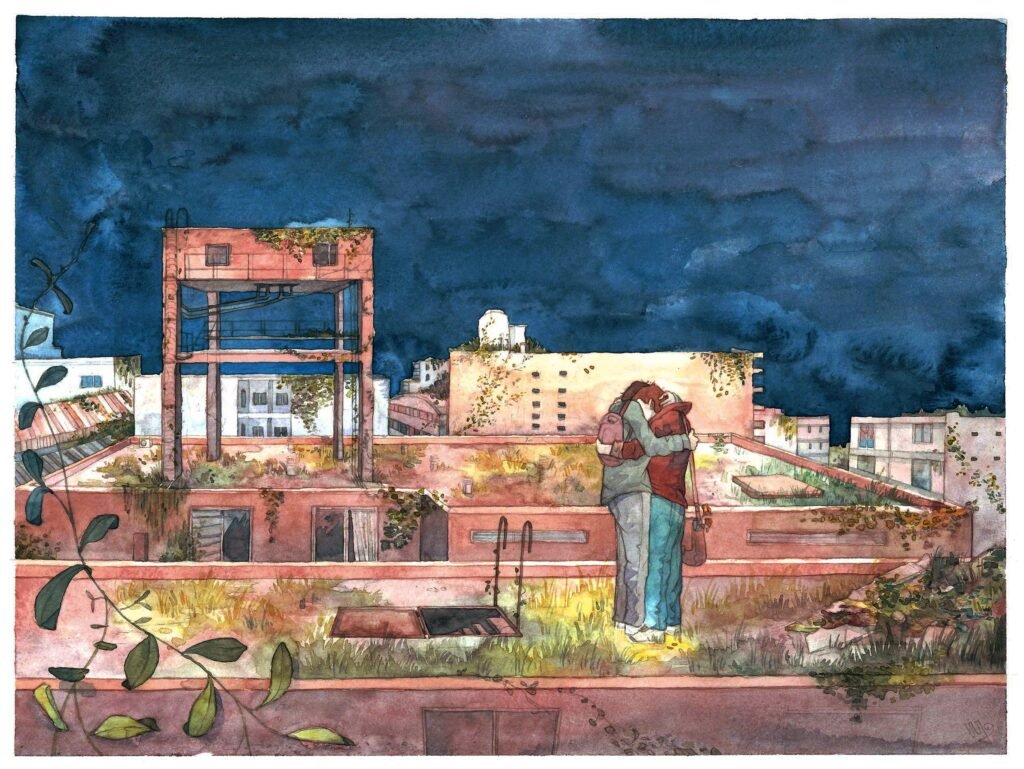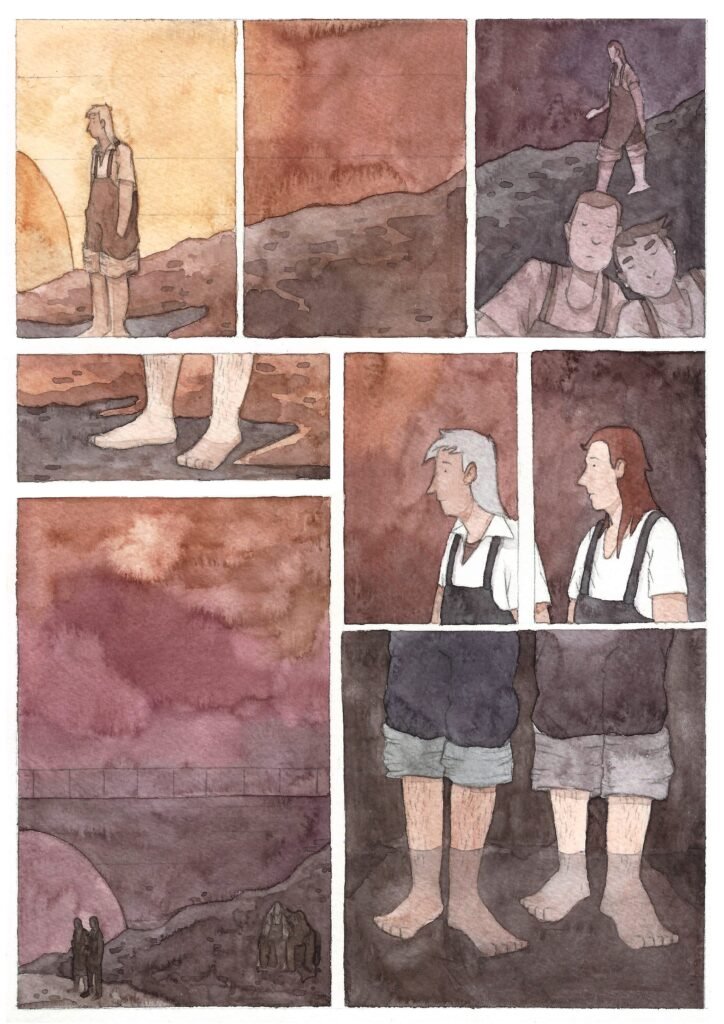Lucía Martínez Mayer (Buenos Aires, 2000) is an emerging talent in the world of comics and illustration, seamlessly blending storytelling with visual beauty. A philosophy student, comic artist, and illustrator, she studied under Mariano Díaz Prieto and the renowned Argentinian comic artist Ignacio Minaverry. In this interview with the artist, she takes us through her creative journey, inspirations, and artistic process.
Lucía’s debut graphic novel, Lo mejor que tenemos (Locorabia, 2022), was awarded third prize in the Argentine National Fund for the Arts 2021 contest in the Graphic Novel category, marking her as a rising voice in the field. In El principio de todas las cosas (Hotel de las Ideas, 2023), she crafts a compelling narrative about loss, activism, and transformation, set against a backdrop of environmental and social struggle.
Her illustrations, often featuring delicate line work and muted color palettes, create an intimate atmosphere that invites viewers into her contemplative world. Through her art, she explores themes of environmental activism, personal transformation, and societal tensions, reflecting a deep engagement with contemporary issues. She has a way of illustrating quiet moments with a tenderness that makes even the smallest gestures—like the way a hand reaches out or a glance lingers—feel profound.
Lucía, describe your art in three words?
Colorful, nostalgic and calm.
Why do you create art?
Painting in watercolors and making art is, for me, a beautiful excuse to tell stories.
What emotions or ideas do you hope people experience when they engage with your art?
I would like to convey a sense of nostalgia that encourages people to reflect on the current state of the world. I try to imagine scenes and images that capture emotions not often represented in mainstream media, such as despair, sadness, or apathy. These “negative affects” are often disregarded as “bad,” yet I believe that those feelings, which make us vulnerable, are the ones that allow us to connect with each other and keep going.
Tell me about one of your favorite artworks you’ve created.
I especially like one of the many apocalyptic paintings I’ve done. In this one, there are two people hugging in the foreground, and in the background, we can see a city covered in plants and moss.
I think I managed to capture how desperate and necessary the hug is, while also showing how beautiful destruction can look. During the pandemic, we were isolated, and all kinds of animals suddenly appeared all over the world. Beauty and tragedy were all mixed together.
Sometimes, I like to imagine that, although everything may seem absurd and tragic, there are living things, like plants, moss, and flowers, that might still be growing somewhere else.
What does your creative routine look like? Do you follow a strict structure or work more intuitively?
I would like to have a consistent creative routine, because that would mean I’ve managed to make it my full-time job!
Unfortunately, I don’t follow this kind of structure, and as a freelance illustrator and Philosophy major, I have to find time to sit down and develop my personal projects. Usually, when I do have the time, I love to work intuitively while also following a structure!
For example, while working on my first graphic novel, I had no idea how it was going to end, and I like to think I found the conclusion of the story while making my way through it.
But the routine was strict: I painted for almost two months straight, every day, all day. I would draw, ink the drawing, and then paint with watercolors. This routine—draw, ink, paint, and repeat until finished—has been with me alongside many other illustration and comic projects. Maybe I’m more structured than I thought!
What’s one new thing you’ve learned about art recently?
While reading a book by Benjamin Labatut called “Un verdor terrible”, I found out that “Prussian blue” is not only the first synthetic pigment, but it was also the origin of cyanide, which was later used in World War I and II as a poisonous gas.
I didn’t know that the discovery of a color could have such a—terrible—impact on the world.
What’s the most exciting part of creating art?
I absolutely love painting with watercolor. I think that choosing a color palette, mixing the colors, and painting are some of my favorite parts.
But I believe the most exciting thing is connecting with people and being able to express something just by spreading colored water on paper.
📖 A Book:
"Maus" by Art Spiegelman - a perfect example of a must-read book that showcases how important it is to keep telling stories
📍 A Place:
Bookshops
💡 Inspiring Things:
Coffee and books
🖌️️ Recommended Artist:
Ignacio Minaverry, an Argentinian comic artist who is simply incredible
If you weren’t an artist, what would you be?
A philosopher! I’m actually finishing my major, and I would love to work in the Academia.
Have you ever faced a major creative block? What helped you break through it?
Yes, yes I have. When I spend too little time drawing and painting, I tend to develop a creative block and become incapable of doing the work I’d like to create. Everything I draw seems a little off. I’ve learned that drawing is like riding a bike: you don’t forget, you just do it poorly when you haven’t practiced in a while. But that’s okay.
The good thing is that there’s always time to keep doing it. It doesn’t have to be perfect, it just has to be. Of course, it’s easier said than done, but you get used to it.
Strangest thing that has inspired you?
The pandemic. I think it was my worst year in terms of mental health, and I haven’t painted as much in years. I wouldn’t go through it again, for obvious reasons, but the amount of work I got done… Sometimes I wonder how I managed to do it.
What’s one rule in art you love breaking?
Always clean your brushes, haha. I would love to say I do, but…
How has your environment or where you live influenced your work?
I grew up in an intellectual family that appreciated books and reading, and I couldn’t go to sleep without a bedtime story. So, the bookish themes that appear in my work have a lot to do with our love for literature and reading.
Buenos Aires, the city where I live, is one of the cities with most bookshops per person. I think my obsession with telling stories through images has a lot to do with all of it.
If you could give one piece of advice to your younger self as an artist, what would it be?
You’re doing really well. Keep going, it seems hard—and it is—but believe me, you’ll love it.
All images courtesy of the artist.









